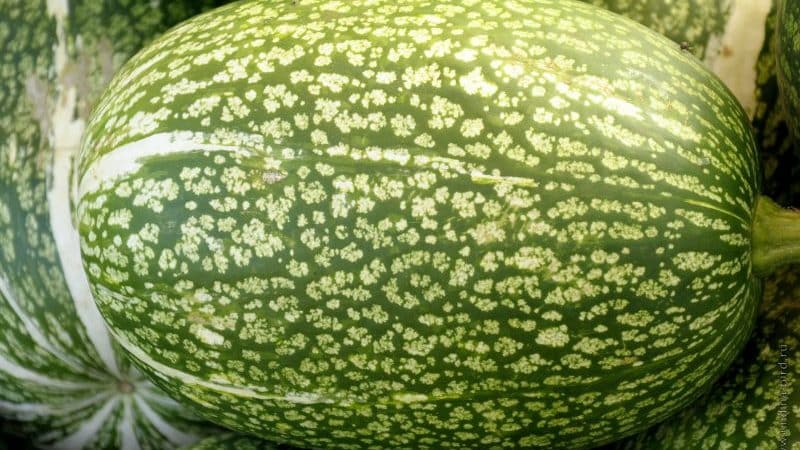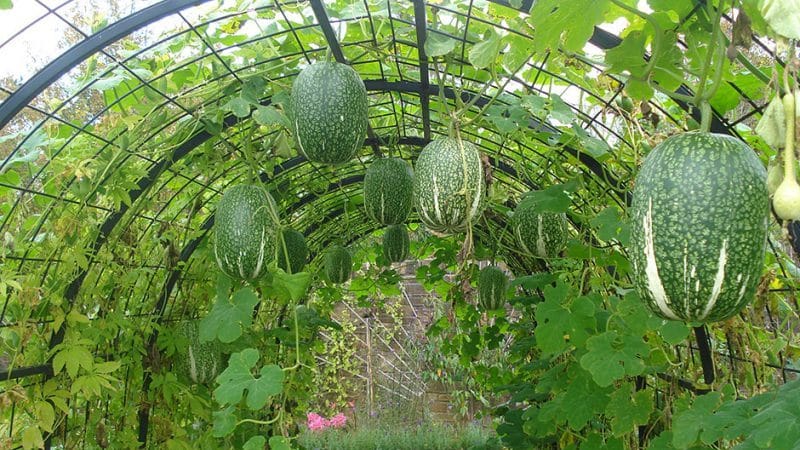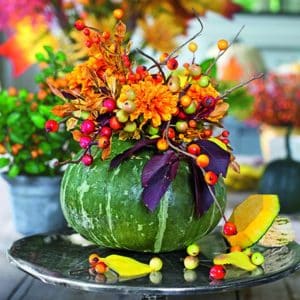What is figleaf pumpkin: features of the species and its use in cooking and folk medicine
People have been growing pumpkins for about 8,000 thousand years. A fruitful and nutritious vegetable that does not require complex care, it has always been a good helper in the household. Endless possibilities in cooking, making dishes from dried pumpkins, a loofah for a bath, decorative use - these are the advantages of a faithful friend of humanity.
Among the many pumpkin varieties there are exotic and unfamiliar to our regions. It was only recently that a wonderful southern guest, phycephalia, began to appear on the plots.
What is figoleaf gourd (phycephaly)
Figolifolia pumpkin (lat. Cucurbita ficifolia) is a perennial plant of the Cucurbitaceae family. Phycephalia (the second name of the species) is a herbaceous vine native to South America. The pumpkin got its name from its beautiful curly leaves, reminiscent of the leaves of a fig tree.
In the climate of the middle zone this type of pumpkin is grown only as an annual. Unpretentious and high-yielding, phycephalia grows well in hot countries and in northern latitudes. It is resistant to frost, many diseases and is not capricious in the choice of soil.

Characteristics and description
Late-ripening crop, shoots are strong and fast-growing (up to 3 m in length). Long vines with beautiful leaves will help create a cozy decor on the site if you let them along a hedge or gazebo. Proper placement of vines in the sun will increase productivity.
The growth period is about 120 days from the moment of germination.Phycephalia is not afraid of temperature changes and frosts down to -3°C. It tolerates cold morning fogs well, and is therefore immune to powdery mildew and fungal diseases. But it is necessary to monitor and treat pests; the plant is sometimes attacked by aphids.
The figleaf pumpkin has a long flowering period. It begins one and a half months after germination and lasts about 30 days. Another plus for decorativeness is the bright yellow-orange flowers. The fruits resemble small watermelons, green in color with white spots or stripes. In northern latitudes they reach from 2 to 5 kg, in warmer climates - up to 8 kg.
Reference. Sometimes phycephalia is used as a basis for grafting other varieties of pumpkins, zucchini and watermelons. Its remarkable natural immunity increases the resistance of the grafted crop to disease.

Uses of figoleaf gourd
Excellent taste will please everyone. Particular attention should be paid to phycephaly for those who do not really like pumpkin - unlike other types, this one does not have a specific pumpkin flavor and Recommended for diet and nutritional therapy.
The white, tender and juicy pulp is suitable for preparing any pumpkin dishes. The strong and hard peel will keep the vegetable fresh for several months. Young shoots and seeds are also used in cooking and folk medicine.
In cooking
Pumpkin recipes several hundred. The pulp is used to make porridges, puree soups, baked, stewed, and used as a filling for pies and as a component of dough. Thanks to its delicate sweetish taste, fig pumpkin is especially good in desserts. We offer a simple dessert recipe - tasty and healthy for the whole family.
Candied pumpkin:
- Cut the peeled pulp into thin slices.
- Prepare syrup (the ratio of water and sugar is 1 tbsp per 700 g).
- Add lemon or orange slices to the syrup to suit your taste.
- Boil the pumpkin pieces in boiling syrup for 5-7 minutes, turn off and let cool. Repeat the boiling process twice.
- Remove the pumpkin slices, let the syrup drain and dry in the oven, electric dryer or in the sun.
- Roll the finished candied fruits in powdered sugar. Store in a sealed container in a cool place.
In folk medicine
First of all, pumpkin is good for the gastrointestinal tract and cardiovascular system.
Other medicinal properties:
- supports pancreatic function and promotes insulin production;
- has a beneficial effect on the liver;
- reduces blood cholesterol levels;
- Healing compresses and masks are prepared from pumpkin pulp: their indications are burns, irritations, dermatitis and other skin problems.
Pumpkin pulp is successfully used in dietary and therapeutic nutrition. If you want to adjust your weight and improve your figure, the figleaf pumpkin will be your faithful assistant in creating the right diet. Pumpkin has no restrictions, only individual intolerance to the product, but this is extremely rare.
Pumpkin seeds – a source of natural protein, vitamins and minerals. Natural antioxidants make them especially valuable. A salad with pumpkin seeds will always be useful.
Diet vitamin salad

You can use any greens you like in this recipe. For example, make a combination of spinach, watercress, parsley.
- Wash and chop fresh herbs. Cut the paprika into thin strips. Grate the carrots on a medium grater.
- Gently mix the ingredients, add the peeled and dried pumpkin seeds.
- Season with filling (olive or sunflower oil, a few drops of lemon juice, a pinch of salt, garlic and spices to your taste). Leave the pouring for 10-15 minutes.
- Sprinkle the salad with sesame seeds, it will decorate the dish and add its own flavor.
Growing

Fig pumpkin adapts well to different climatic conditions. You can grow it even in Siberia and the Urals, you just need proper care of the crop.
Growing seedlings
The time to sow figleaf pumpkin is in April.

The algorithm is as follows:
- Pre-soak the seeds in warm water for two to three days and germinate.
- Prepare a mixture of turf soil, peat and sawdust in pots. Sprinkle wood ash on top to prevent pests.
- Plant the seeds, keep the seedlings for three weeks at a temperature of +15-17°C, water moderately.
- Seedlings can be kept up to the fifth leaf (about a month).
- Light it with a lamp if there are a lot of cloudy days in spring.
Transplantation into the ground and further care
Before planting seedlings in the ground water with organic fertilizer or add it to the soil. Choose an open, sunny place - phycephalia loves warmth and light. Make holes 10 cm deep at a distance of 2 m from each other. Phycephalia needs large spaces.
After the sixth or seventh leaf, pinch the top bud so that side shoots will appear. This will shape and guide the plant's stems. If long vines without side shoots are more suitable for your site, pinching is not necessary. Flowering begins in July, and the ovary appears in early August. Water the plant moderately. During fruit set, re-fertilize the soil with diluted organic matter.
Reference. Phycephalia does not cross-pollinate with other types and varieties of pumpkins.
Harvesting and application
The fruits ripen in autumn. To speed up ripening, you can pinch off all the growth buds and sprinkle them with soil. Stop watering two weeks before harvesting the fruits. Phycephalia tolerates the first autumn frosts well, so it is better to collect it after the leaves have completely withered. In a mature pumpkin, the stalk becomes very hard and gradually dies. The peel also hardens. Ripe seeds are black.
Important! Three main signs that it is time to harvest: drying of the vines, woodiness of the stalk, hardening of the peel.
Cut the pumpkin with pruning shears, leaving a stalk of at least 5 cm. For long-term storage, select whole, undamaged, smooth fruits. Place dry and clean pumpkins carefully so that they do not fall or hit. At the point of impact, the fruit begins to deteriorate faster. Store in a cool, dark pantry.

Pumpkin has another advantage - a hard peel. So don't rush to throw it away. If you evenly cut off the top with the petiole, carefully remove the pulp and seeds, and dry the empty fruit and show a little imagination, the decor of your home and garden will only benefit from a variety of pumpkin crafts. The fruit can be primed, painted and made into an unusual vase. Cover with varnish, insert an oasis for flowers soaked in water inside and create an amazing ikebana.
And especially sophisticated craftsmen will be captivated by carving - the art of artistic pumpkin carving.
Conclusion
Phycephalia will be a wonderful new product for all summer residents and amateur agronomists. Unpretentious and fast-growing, it will delight you with its decorativeness and delicious fruits. Small pumpkins are convenient for cooking. Long shelf life and wonderful taste - figleaf pumpkin has it all.
Good informative article, I liked the idea of decorating pumpkins, I’ll run to grow them, thank you
Growing up in the Northern Urals is a heroic act! What a great guy you are!